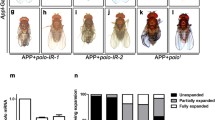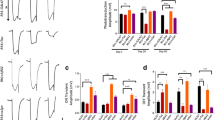Abstract
The Down syndrome critical region 1 (DSCR1), a Down syndrome-associated protein, is an endogenous inhibitor of the Ca2+-dependent phosphatase calcineurin. It has been also suggested to be associated with Alzheimer’s disease (AD) but the role of DSCR1 in the pathogenesis of AD still remains controversial. In this paper, we investigated the effects of knockdown of sarah (sra), a Drosophila DSCR1 ortholog, on the Aβ42-induced developmental phenotypes of Drosophila. Knockdown of sra showed detrimental effects on the rough eye phenotype and survival of Aβ42-expressing flies without altering the Aβ42 accumulation. Furthermore, the knockdown of sra increased glial cell numbers in the larval brains and its susceptibility to oxidative stress. Overexpression of an active form of calcineurin produced similar results to sra knockdown as they both exacerbated the Aβ42-induced rough eye phenotype. However, sra knockdown did not alter apoptosis or c-Jun N-terminal kinase activation in Aβ42-expressing flies. In conclusion, our results suggest that sra does play an important role in Aβ42-induced developmental defects in Drosophila without affecting its stress responses.






Similar content being viewed by others
Abbreviations
- Aβ42 :
-
Amyloid-β-42
- AD :
-
Alzheimer’s disease
- DS :
-
Down syndrome
- DSCR1 :
-
Down syndrome critical region 1
- Sra :
-
Sarah
References
Agostinho P, Lopes JP, Velez Z, Oliveira CR (2008) Overactivation of calcineurin induced by amyloid-beta and prion proteins. Neurochem Int 52:1226–1233
Ashe KH, Zahs KR (2010) Probing the biology of Alzheimer’s disease in mice. Neuron 66:631–645
Berridge MJ (2010) Calcium hypothesis of Alzheimer’s disease. Pflug Archiv 459:441–449
Bezprozvanny I, Mattson MP (2008) Neuronal calcium mishandling and the pathogenesis of Alzheimer’s disease. Trends Neurosci 31:454–463
Brait VH, Martin KR, Corlett A, Broughton BR, Kim HA, Thundyil J, Drummond GR, Arumugam TV, Pritchard MA, Sobey CG (2012) Over-expression of DSCR1 protects against post-ischemic neuronal injury. PLoS One 7:e47841
Casas-Tinto S, Zhang Y, Sanchez-Garcia J, Gomez-Velazquez M, Rincon-Limas DE, Fernandez-Funez P (2011) The ER stress factor XBP1s prevents amyloid-beta neurotoxicity. Hum Mol Genet 20:2144–2160
Chang KT, Min KT (2005) Drosophila melanogaster homolog of Down syndrome critical region 1 is critical for mitochondrial function. Nat Neurosci 8:1577–1585
Chang KT, Shi YJ, Min KT (2003) The Drosophila homolog of Down’s syndrome critical region 1 gene regulates learning: implications for mental retardation. Proc Natl Acad Sci USA 100:15794–15799
Crowther DC, Kinghorn KJ, Miranda E, Page R, Curry JA, Duthie FA, Gubb DC, Lomas DA (2005) Intraneuronal Abeta, non-amyloid aggregates and neurodegeneration in a Drosophila model of Alzheimer’s disease. Neuroscience 132:123–135
Davies KJ, Ermak G, Rothermel BA, Pritchard M, Heitman J, Ahnn J, Henrique-Silva F, Crawford D, Canaider S, Strippoli P et al (2007) Renaming the DSCR1/Adapt78 gene family as RCAN: regulators of calcineurin. FASEB J 21:3023–3028
Ermak G, Davies KJ (2003) DSCR1(Adapt78)-a Janus gene providing stress protection but causing Alzheimer’s disease? IUBMB Life 55:29–31
Ermak G, Morgan TE, Davies KJ (2001) Chronic overexpression of the calcineurin inhibitory gene DSCR1 (Adapt78) is associated with Alzheimer’s disease. J Biol Chem 276:38787–38794
Ermak G, Sojitra S, Yin F, Cadenas E, Cuervo AM, Davies KJ (2012) Chronic expression of RCAN1-1L protein induces mitochondrial autophagy and metabolic shift from oxidative phosphorylation to glycolysis in neuronal cells. J Biol Chem 287:14088–14098
Fuentes JJ, Genesca L, Kingsbury TJ, Cunningham KW, Perez-Riba M, Estivill X, de la Luna S (2000) DSCR1, overexpressed in Down syndrome, is an inhibitor of calcineurin-mediated signaling pathways. Hum Mol Genet 9:1681–1690
Gajewski K, Wang J, Molkentin JD, Chen EH, Olson EN, Schulz RA (2003) Requirement of the calcineurin subunit gene canB2 for indirect flight muscle formation in Drosophila. Proc Natl Acad Sci USA 100:1040–1045
Greeve I, Kretzschmar D, Tschape JA, Beyn A, Brellinger C, Schweizer M, Nitsch RM, Reifegerste R (2004) Age-dependent neurodegeneration and Alzheimer-amyloid plaque formation in transgenic Drosophila. J Neurosci 24:3899–3906
Hardy J, Selkoe DJ (2002) The amyloid hypothesis of Alzheimer’s disease: progress and problems on the road to therapeutics. Science 297:353–356
Harris CD, Ermak G, Davies KJ (2007) RCAN1-1L is overexpressed in neurons of Alzheimer’s disease patients. FEBS J 274:1715–1724
Hong YK, Lee S, Park SH, Lee JH, Han SY, Kim ST, Kim YK, Jeon S, Koo BS, Cho KS (2012) Inhibition of JNK/dFOXO pathway and caspases rescues neurological impairments in Drosophila Alzheimer’s disease model. Biochem Biophys Res Commun 419:49–53
Iijima K, Liu HP, Chiang AS, Hearn SA, Konsolaki M, Zhong Y (2004) Dissecting the pathological effects of human Abeta40 and Abeta42 in Drosophila: a potential model for Alzheimer’s disease. Proc Natl Acad Sci USA 101:6623–6628
Jeong H, Han SY, Lee M, Lee S, Shin M, Jeon Y, Lee K, Cho KS (2015) Roles of Tsp66E and Tsp74F in border cell migration and the maintenance of border cell adhesion in Drosophila. Genes Genom 37:559–565
Kim SS, Jang SA, Seo SR (2013) CREB-mediated Bcl-2 expression contributes to RCAN1 protection from hydrogen peroxide-induced neuronal death. J Cell Biochem 114:1115–1123
Kingsbury TJ, Cunningham KW (2000) A conserved family of calcineurin regulators. Genes Dev 14:1595–1604
Kurabayashi N, Sanada K (2013) Increased dosage of DYRK1A and DSCR1 delays neuronal differentiation in neocortical progenitor cells. Genes Dev 27:2708–2721
Lee S, Bang SM, Lee JW, Cho KS (2014) Evaluation of traditional medicines for neurodegenerative diseases using Drosophila models. Evid Based Complement Altern Med 2014:967462
Lee EH, Kim SS, Lee S, Baek KH, Seo SR (2015a) Pituitary adenylate cyclase-activating polypeptide (PACAP) targets Down syndrome candidate region 1 (DSCR1/RCAN1) to control neuronal differentiation. J Biol Chem 290:21019–21031
Lee S, Bang SM, Hong YK, Lee JH, Jeong H, Park SH, Liu QF, Lee IS, Cho KS (2015b) The calcineurin inhibitor, Sarah/Nebula, exacerbates Abeta42 phenotypes in a Drosophila model of Alzheimer’s disease. Dis Model Mech. doi:10.1242/dmm.018069
Li Y, Wang J, Zhou Y, Li D, Xiong ZQ (2015) Rcan1 deficiency impairs neuronal migration and causes periventricular heterotopia. J Neurosci 35:610–620
Liu F, Grundke-Iqbal I, Iqbal K, Oda Y, Tomizawa K, Gong CX (2005) Truncation and activation of calcineurin A by calpain I in Alzheimer disease brain. J Biol Chem 280:37755–37762
Liu QF, Lee JH, Kim YM, Lee S, Hong YK, Hwang S, Oh Y, Lee K, Yun HS, Lee IS et al (2015) In vivo screening of traditional medicinal plants for neuroprotective activity against Abeta42 cytotoxicity by using Drosophila models of Alzheimer’s disease. Biol Pharm Bull 38:1891–1901
Lott IT, Head E (2005) Alzheimer disease and Down syndrome: factors in pathogenesis. Neurobiol Aging 26:383–389
Markesbery WR (1997) Oxidative stress hypothesis in Alzheimer’s disease. Free Radic Biol Med 23:134–147
Martin KR, Corlett A, Dubach D, Mustafa T, Coleman HA, Parkington HC, Merson TD, Bourne JA, Porta S, Arbones ML et al (2012) Over-expression of RCAN1 causes Down syndrome-like hippocampal deficits that alter learning and memory. Hum Mol Genet 21:3025–3041
Mattson MP (2004) Pathways towards and away from Alzheimer’s disease. Nature 430:631–639
Park J, Oh Y, Chung KC (2009) Two key genes closely implicated with the neuropathological characteristics in Down syndrome: DYRK1A and RCAN1. BMB Rep 42:6–15
Park SH, Lee S, Hong YK, Hwang S, Lee JH, Bang SM, Kim YK, Koo BS, Lee IS, Cho KS (2013) Suppressive effects of SuHeXiang Wan on amyloid-beta42-induced extracellular signal-regulated kinase hyperactivation and glial cell proliferation in a transgenic Drosophila model of Alzheimer’s disease. Biol Pharm Bull 36:390–398
Porta S, Serra SA, Huch M, Valverde MA, Llorens F, Estivill X, Arbones ML, Marti E (2007) RCAN1 (DSCR1) increases neuronal susceptibility to oxidative stress: a potential pathogenic process in neurodegeneration. Hum Mol Genet 16:1039–1050
Reese LC, Taglialatela G (2011) A role for calcineurin in Alzheimer’s disease. Curr Neuropharmacol 9:685–692
Rothermel B, Vega RB, Yang J, Wu H, Bassel-Duby R, Williams RS (2000) A protein encoded within the Down syndrome critical region is enriched in striated muscles and inhibits calcineurin signaling. J Biol Chem 275:8719–8725
Shaw JL, Chang KT (2013) Nebula/DSCR1 upregulation delays neurodegeneration and protects against APP-induced axonal transport defects by restoring calcineurin and GSK-3beta signaling. PLoS Genet 9:e1003792
Shibasaki F, Hallin U, Uchino H (2002) Calcineurin as a multifunctional regulator. J Biochem 131:1–15
Sobrado M, Ramirez BG, Neria F, Lizasoain I, Arbones ML, Minami T, Redondo JM, Moro MA, Cano E (2012) Regulator of calcineurin 1 (Rcan1) has a protective role in brain ischemia/reperfusion injury. J Neuroinflammation 9:48
Sullivan KM, Rubin GM (2002) The Ca(2+)-calmodulin-activated protein phosphatase calcineurin negatively regulates EGF receptor signaling in Drosophila development. Genetics 161:183–193
Sun X, Wu Y, Chen B, Zhang Z, Zhou W, Tong Y, Yuan J, Xia K, Gronemeyer H, Flavell RA et al (2011) Regulator of calcineurin 1 (RCAN1) facilitates neuronal apoptosis through caspase-3 activation. J Biol Chem 286:9049–9062
Sun X, Wu Y, Herculano B, Song W (2014) RCAN1 overexpression exacerbates calcium overloading-induced neuronal apoptosis. PLoS One 9:e95471
Takeo S, Tsuda M, Akahori S, Matsuo T, Aigaki T (2006) The calcineurin regulator sra plays an essential role in female meiosis in Drosophila. Curr Biol 16:1435–1440
Walsh DM, Selkoe DJ (2004) Deciphering the molecular basis of memory failure in Alzheimer’s disease. Neuron 44:181–193
Wang W, Zhu JZ, Chang KT, Min KT (2012) DSCR1 interacts with FMRP and is required for spine morphogenesis and local protein synthesis. EMBO J 31:3655–3666
Wirths O, Multhaup G, Bayer TA (2004) A modified beta-amyloid hypothesis: intraneuronal accumulation of the beta-amyloid peptide-the first step of a fatal cascade. J Neurochem 91:513–520
Wu HY, Hudry E, Hashimoto T, Kuchibhotla K, Rozkalne A, Fan Z, Spires-Jones T, Xie H, Arbel-Ornath M, Grosskreutz CL et al (2010) Amyloid beta induces the morphological neurodegenerative triad of spine loss, dendritic simplification, and neuritic dystrophies through calcineurin activation. J Neurosci 30:2636–2649
Acknowledgments
This paper was supported by Konkuk University in 2013.
Author information
Authors and Affiliations
Corresponding author
Ethics declarations
Conflict of Interest
The authors declare that they have no conflict of interest.
Informed consent
Informed consent was obtained from all individual participants included in the study.
Research involving human participants and/or animals
This article does not contain any studies with human participants or animals performed by any of the authors.
Additional information
Se Min Bang and Soojin Lee have contributed equally to this work.
Rights and permissions
About this article
Cite this article
Bang, S.M., Lee, S., Jeong, H. et al. Effects of sarah/nebula knockdown on Aβ42-induced phenotypes during Drosophila development. Genes Genom 38, 479–487 (2016). https://doi.org/10.1007/s13258-016-0407-5
Received:
Accepted:
Published:
Issue Date:
DOI: https://doi.org/10.1007/s13258-016-0407-5




